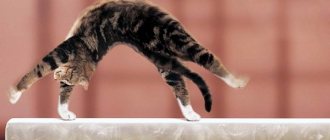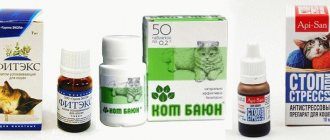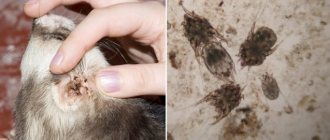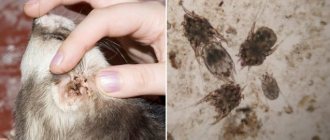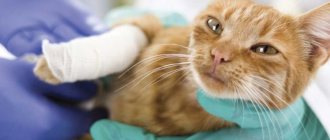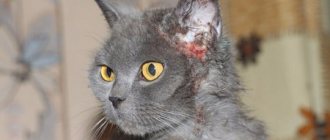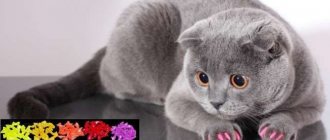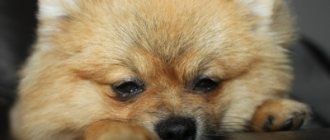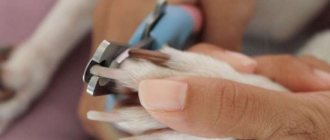A cat's claws that are too long can not only damage furniture and carpeting, but also injure the animal's paw. Sharp, untreated claws bother your pet and grow into the pads, causing an inflammatory process, so they must be regularly treated with nail clippers. They are safe and, thanks to well-thought-out limiters, do not touch the pads and blood vessels, and the cut claws do not delaminate.
What is a nail clipper?
Cats have thick, curved claws that cannot be shortened with ordinary scissors. Using an unsuitable tool may cause bleeding or serious injury. Some owners trust groomers to carry out hygiene procedures. But to keep your claws in order, you need to visit a grooming salon every month.
In order to save time and effort, many breeders prefer to process the paws themselves. To do this, they use a functional tool. Nail cutter – special scissors for trimming cat claws. The durable design allows you to trim claws quickly and painlessly, without the risk of damaging the phalanx or root.
Why is it needed?
Ordinary scissors or manicure accessories will not work because they can cause discomfort to both the animal and its owner. After all, the structure of a human nail and a cat’s claw is different. Therefore, hygiene procedures should be performed only with special devices. Fortunately, the choice is now wide.
A kitten should be trained to use a nail clipper from the age of 1 month. It is recommended to trim claws as they grow.
Why can't I use regular wire cutters or scissors?
The human nail plate is thin and round in shape. The structure of a cat's nail is different. The claws resemble a sickle - convex and curved downwards.
Let's talk about anatomy to avoid injury to blood vessels:
- Each cat has 18 toes - 5 on the front paws, 4 on the back paws.
- While the phalanges are relaxed, the claws are not visible. To cut the length, you need to lightly press on each finger.
- The claw consists of a pulp (closer to the base) and a horny part. The pulp contains nerve endings and small blood vessels. You need to trim the claw so as not to hurt it.
- The fifth toe on the front paws is slightly higher than the rest. He also needs a manicure.
If you use ordinary scissors for a hygienic procedure, you can crush the nail plate, damage blood vessels and stress the animal.
To avoid bleeding and injury, it is better to use a nail clipper for cats. We will tell you further about which one is better to choose.
Types of devices
There are variations of nail clippers of different types, models, shapes and designs. There are some that are very easy to use - they are suitable for novice cat owners, and there are special ones designed for professional breeders and groomers.
Before going to the store, it is better to find out what the differences are between the main types of nail clippers, as well as their advantages and disadvantages.
Guillotine
This type of tool consists of two working parts: movable and fixed. Trimming is performed by a moving part, which is installed perpendicular to the claw placed in a special hole. The use of guillotine claw clippers requires certain skills, since when fixing the nail plate it is not visible. However, despite this disadvantage, guillotine-type tools are very popular - especially among owners of large cats with hard claws.
Scissor nail clipper
Scissors are the simplest solution. Outwardly, they resemble human manicures, only with rounded blades and a hole in the middle. It is intended for laying the claw and fixing it during the procedure.
The tool is very easy to use: you place a cat's claw in the notch, the handles close together, and the result is a neat, smooth cut. Suitable for small cats and kittens.
Nail clipper-secateurs
Resembles regular wire cutters or needle nose pliers. The handles have rubber linings, fit comfortably in the hand and do not slip. The spring included in the mechanism also makes working with the accessory easier. The cut is better than that of scissors.
Most models are equipped with a special limiter that sets a certain length and protects against cutting off excess. A special safety lock blocks the cutting surfaces when the pliers are not in use. There are straight and curved models on the pet products market.
Electric nail clipper or grinder
This is a power tool, so it is the most functional and expensive. During operation, the grinder head with an abrasive coating rotates and grinds down the claw plate like a nail file. The device comes with various attachments and limiters.
A beginner without the skill of working with an electric grinder can easily injure a pet by affecting the living part of the claw. Such devices are more often used in professional grooming salons. In stores you can find models that operate on mains power, batteries, and rechargeable batteries.
How to use a cat nail clipper?
Cats need a manicure 1-2 times a month or as the nail plate grows. In order for your pet to take the hygiene procedure for granted, it is necessary to teach it to manipulation from an early age. Talk to the kitten, gently stroke the head, do not scream, gently press on the pad to see the claw.
For a “manicure” you need to use a high-quality, perfectly sharpened tool to avoid peeling of the nail and injury. Please read the instructions before use.
Proceed with the procedure, following the algorithm:
- Use gentle pressure to squeeze the pad of your finger to reveal the claw;
- inspect the plate, visually determine the length that needs to be cut;
- step back from the pulp 2-3 millimeters, position the nail clipper blade perpendicular to the plate;
- With a confident movement of your fingers, squeeze the ends of the nail clipper;
- Wipe the treated claw with a swab soaked in antiseptic or hydrogen peroxide.
In the video you can see how painlessly cats trained from childhood endure the procedure:
You already know that the area of the plate in which the vascular bundle is located has a darker color. You only need to cut off the light part where there are no nerve endings. In some cat breeds, the claw along its entire length is dark and dense - it is difficult to independently determine the place for cutting. In such cases, you need to contact a veterinarian or groomer, who will tell you how to properly cut off overgrown claws yourself.
Reviews
Positive reviews speak about the benefits of the nail clipper. You can also leave your reviews and impressions about different types of nail clippers for cats, they will be useful to other users!
Anonymous writes:
“My cat scratched the furniture, tore the wallpaper, and ruined the upholstery of the sofa. I was recommended to buy a nail clipper. After purchasing a nail clipper and scissors, we decided to make repairs and new furniture.”
Natalia's review:
“I picked up a cat on the street. She was a little wild and timid. The more she got used to the new place, the more the chairs, wallpaper and mattress on the bed suffered from her games. In addition, during games, she released her claws and scratched. After purchasing a nail cutter and scissors, playing with your pet became a pleasure. The nail clipper itself is easy to use and small in size.”
A cat lover writes:
“For my Barsik I buy all the best. I try to pamper him with toys and care products. Despite the cat's peaceful disposition, he often released his claws. One day I saw a nail clipper and pruner on the store’s website and decided to buy it. Thanks to my purchase, all scratches are a thing of the past.”
How to prepare the animal and the instrument?
Treat paws in a room with good lighting. Before the procedure, make sure that the cat is fed, healthy, and does not want to go to the toilet. Calm the animal, pick it up, stroke it, tell it that you are not going to hurt it.
It is good if the cat sniffs the tool before use. This is an important psychological moment.
To avoid infecting your pet, you need to prepare the following tools:
- wipe the nail clipper with an alcohol-containing solution;
- put hemostatic agents nearby for first aid: bandage, cotton pads;
- Wash your hands or use disposable gloves.
At the end of the procedure, praise the purr, tell him that he did a great job, give him his favorite treat. If this is your first time getting a manicure, call someone for help. One person will hold the animal tightly in his arms, the second will do the haircut. If this is not possible, wrap the cat in a towel to avoid scratches and accidental injury to the pulp.
If you injure your pet, treat the damaged area with hydrogen peroxide. If bleeding continues for more than 30 minutes, take your pet to the veterinarian.
What procedures apply?
To prevent your pet from scratching, damaging furniture, and to preserve your pet’s health, to prevent claws from growing into the crumbs, and also to prevent the introduction of pathogenic microflora, it is important to pay attention to the condition of your cat’s claws. Care is quite simple, but requires the use of some tools and the owner having the skills to carry out the appropriate manipulations.
As with dogs, in addition to trimming, grooming includes cleansing of dirt and secretions. Often, an unpleasant, thick brown-brown substance accumulates at the base of this organ, especially in older animals. This environment is a great place for harmful bacteria to grow.
It is necessary to regularly check the claws for cleanliness and length. Trim and clean if necessary. To do this, use tools and moistened cotton gauze pads.
The best nail clippers for cats
To ensure that the purchased nail clipper model does not disappoint, choose the tool responsibly. The guillotine is often chosen by experienced breeders.
Beginner “users” prefer pruning shears. Their mechanism of action allows you to avoid injuries resulting from negligence.
Nail clippers-scissors are bought by those who are more accustomed to using accessories that look like manicure devices for people.
When choosing, you need to pay attention to the following criteria:
- Convenience – the handles of the nail clipper should match the size. The rubberized surface will provide a good grip on the tool.
- Blade - a high-quality nail clipper should be made of stainless steel. The edges of the blade should not have jagged or rough edges.
It’s good if the design of the manicure tool includes a limiter that minimizes the risk of injury.
Manicure for a cat
Trimming claws is an important and necessary procedure for a cat, especially if he lives in an apartment and does not have the opportunity to grind his claws down in natural conditions. Or rather, the cat will sharpen its “weapon” in any case, another question: about what? The scratching posts and special toys you bought may well not please the cat, and then he will begin to scratch furniture and wallpaper, clothes and bags... It is doubtful that this will please you.
Cat manicure is a simple way to solve many complex problems.
Scratching is a natural process, not pampering or harmful. In this way, animals clean and renew their claws, and at the same time mark the territory that they consider their own. How to respect both the cat's and the owner's interests - without casualties and destruction. The simplest and most humane way out is to cut the claws. Different cats' claws grow at different rates, but usually one manicure session lasts for two weeks.
The procedure for trimming nails in a veterinary clinic is inexpensive, but you can easily handle it yourself - why create additional stressful situations for your pet? At home, you can cut not all the claws at the same time, but at least one or two at a time - only those that have become too long and sharp. This approach is easier for even the most impatient pet to handle.
Trim your nails on time - this will make life easier for you and your pet.
First aid for injuries
Most dogs are very worried before trimming their nails , even if they have not experienced negative emotions about this before. One option is relaxation medications. As a rule, sedatives are produced from herbs and weaken nervous excitability, all this gives exactly the effect that is required for a cosmetic procedure. Then prepare special powder, powder or wipes with hemostatic properties. If you cut the claw too deeply, several dozen important vessels will be damaged. Quite often, injuries are accompanied by severe bleeding, and this initiates mutual panic for both dog and owner.
It is important to know that under no circumstances should you treat a damaged claw with the following drugs:
iodine;- fucorcin;
- hydrogen peroxide;
- dimexide;
- alcohol;
- brilliant green;
- vodka.
If you don’t have special powder or baby powder nearby, then ordinary food flour will do. All kinds of cauterizing and alcohol-containing solutions will only increase the pain!
Another rather difficult injury is claw tearing . Most often, this happens if you squeeze the nail clippers for a long time, and the dog suddenly jerks its paw. The secured claw remains in the clamp, and the soft tissue and skin are torn.
The first thing to remember is that this is very painful for the dog! Get ready for your tailed friend to whine loudly and try to run away. Operate quickly enough and without panicking:
- Constantly talk to the dog, console him, do everything in order to distract him from what is happening.
- Intercept the wounded paw with a piece of gauze in the area of the wrist (metatarsus).
- Tighten and secure the gauze thoroughly, while it is recommended to raise the limb as high as possible. Apply cold to the injured paw - ice, a piece of minced meat, frozen vegetables taken from the freezer. Wrap the compress in cotton cloth and cellophane in advance. Cold can help stop blood flow and moderate the pain to some extent.
- Carefully examine the wound, and if there are open tissue tears, fill them with novocaine or lidocaine.
Selection rules
The owner decides how to cut his animal's claws. For pruning, you can use any specialized devices, the main thing is to choose them so that they are ideally convenient.
A good nail clipper should fit your hand so that you can use it without any extra effort. If the cat owner has small hands, there is no need to take a large and difficult-to-use tool, but for large hands, miniature accessories will be inconvenient.
A very important condition is the sharpness of the blades. It depends on the quality of the metal used, so a good nail clipper cannot be very cheap. The investment will be justified by the long service life of the device and the high quality of nail trimming. Good metal holds an edge for a long time, and the cutting edge becomes razor-quality. This device cuts the claws evenly and accurately, without leaving chips or snags, so after trimming there is no need to carefully file the cut part. This saves time and causes less injury to the animal.
A quality nail clipper should have comfortable handles with a rubberized coating that prevents slipping. During the trimming process, such a tool will not slip out of your hands at the most crucial moment and will not cause damage to the capillary in the cat's claw.
Many owners are interested in which device is best for their cat. It is impossible to answer this question unequivocally, since they all cope with their purpose perfectly. Each owner of furry happiness chooses the best option for himself based on his own preferences.
Training to a scratching post
A cat sharpens its claws on a special scratching post
It is important to choose the right scratching post. Manufacturers offer different designs and colors, so this accessory will fit well into the interior and amuse your pet.
If there is not enough space in the room, it is better to get by with a board that is attached to the wall. This design is suitable for those cats that like to sharpen their claws on wallpaper.
If space allows, you can choose various posts, houses and other various options. Some cats prefer to wear their claws off on the carpet or armrests. Horizontal, surface scratching posts - special rugs, shelves, etc. - are better suited for them.
Having brought a new thing into the house, you need to show it to the cat and praise your pet. Usually cats themselves are enthusiastic about such items. However, if your pet does not want to use the scratching post at all, you need to be patient. You can use special training sprays and powders, and be sure to encourage and motivate your pet. There is no need to wash or wipe the scratching post to retain the cat's scent. This will give your pet confidence and speed up the process of adaptation.
First aid for injuries
Most dogs are very worried before trimming their nails, even if they have not experienced negative emotions about this before. One option is relaxation medications. As a rule, sedatives are produced from herbs and weaken nervous excitability, all this gives exactly the effect that is required for a cosmetic procedure. Then prepare special powder, powder or wipes with hemostatic properties. If you cut the claw too deeply, several dozen important vessels will be damaged. Quite often, injuries are accompanied by severe bleeding, and this initiates mutual panic for both dog and owner.
It is important to know that under no circumstances should you treat a damaged claw with the following drugs:
iodine;- fucorcin;
- hydrogen peroxide;
- dimexide;
- alcohol;
- brilliant green;
- vodka.
If you don’t have special powder or baby powder nearby, then ordinary food flour will do. All kinds of cauterizing and alcohol-containing solutions will only increase the pain!
Another rather difficult injury is claw tearing. Most often, this happens if you squeeze the nail clippers for a long time, and the dog suddenly jerks its paw. The secured claw remains in the clamp, and the soft tissue and skin are torn.
The first thing to remember is that this is very painful for the dog! Get ready for your tailed friend to whine loudly and try to run away. Operate quickly enough and without panicking:
- Constantly talk to the dog, console him, do everything in order to distract him from what is happening.
- Intercept the wounded paw with a piece of gauze in the area of the wrist (metatarsus).
- Tighten and secure the gauze thoroughly, while it is recommended to raise the limb as high as possible. Apply cold to the injured paw - ice, a piece of minced meat, frozen vegetables taken from the freezer. Wrap the compress in cotton cloth and cellophane in advance. Cold can help stop blood flow and moderate the pain to some extent.
- Carefully examine the wound, and if there are open tissue tears, fill them with novocaine or lidocaine.
Codos CP-3400
The model has a built-in battery that is fully charged in 2 hours. Autonomous operation of the model is 3 hours. The nail clipper is equipped with two types of holes, each of which processes the animal’s claws differently. The model is considered completely safe. The nail clipper can also work from the mains, and thanks to the long 2-meter cable, this will be quite convenient.
Pros:
- 3 hours of battery life;
- Can work from the network;
- Long network cable;
- Rotary motor;
- Safety of use.
Minuses:
- High price.
Training kittens
Cats are very willful pets; in their opinion, forcing them to do something unpleasant is unrealistic. And pets often don’t like cutting their claws very much . The sooner you start training, the easier and faster you can achieve results.
To begin with, it is important to show that the owner will never offend. If the kitten does not respond to the call, you can lure it with something tasty or intriguing, for example, a favorite toy. Having established contact, you need to assess his emotional state at the moment. If your pet is relaxed and in a good mood, you can begin training. If the cat is excited or out of sorts, it is better to postpone the procedure until a more appropriate time and just play or caress the pet. It is important that the owner’s actions are non-violent, but at the same time confident.
Once the kitten is relaxed, you can show him the tools. Having placed the pet on your lap, carefully and securely holding the pet, you need to let the nail clipper smell, perhaps the kitten will rub against it (this means that the cat has marked the object, since there are glands on the face that secrete a secretion with an odor that is elusive to humans, but noticeable to cats , and next time the pet will understand that the object is familiar to him and does not pose a threat).
Is it possible and how to rinse a cat’s nose with saline solution?
If the introduction was successful, you can move on. You need to release the claw from the fold of skin, lightly press the cat’s finger and hold the paw in this state. Be sure to reinforce the action with a treat. Next, manipulate all the pet’s fingers. It is important to talk gently and exaggeratedly praise your pet without ceasing.
Then the nail clipper is connected. First, the tool is simply touched to the claw. If the kitten behaves calmly, you can try trimming the claw. You definitely need to treat him with goodies in order to associate such an uncomfortable procedure with something pleasant. If the pet constantly breaks out and gets nervous, it is better to let it go, also giving a treat in parallel with touching it with a nail clipper. But you cannot allow your pet to get used to permissiveness.
